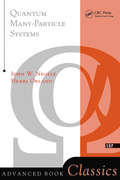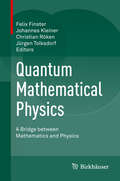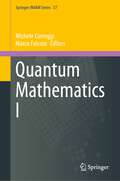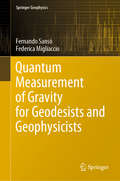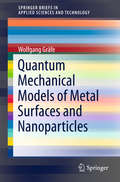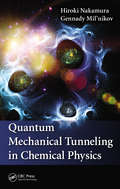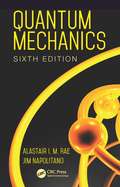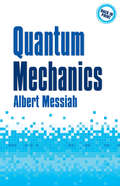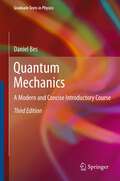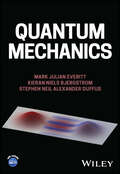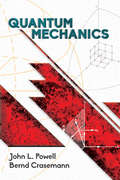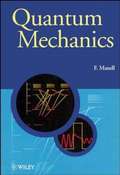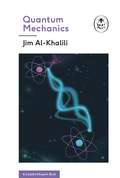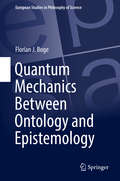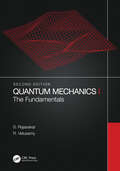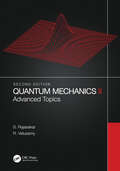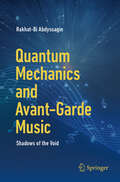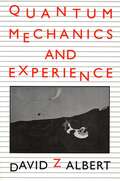- Table View
- List View
Quantum Many-particle Systems (Advanced Books Classics Ser.)
by John W. NegeleThis book explains the fundamental concepts and theoretical techniques used to understand the properties of quantum systems having large numbers of degrees of freedom. A number of complimentary approaches are developed, including perturbation theory; nonperturbative approximations based on functional integrals; general arguments based on order parameters, symmetry, and Fermi liquid theory; and stochastic methods.
Quantum Mathematical Physics
by Felix Finster Johannes Kleiner Christian Röken Jürgen TolksdorfQuantum physics has been highly successful for more than 90 years. Nevertheless, a rigorous construction of interacting quantum field theory is still missing. Moreover, it is still unclear how to combine quantum physics and general relativity in a unified physical theory. Attacking these challenging problems of contemporary physics requires highly advanced mathematical methods as well as radically new physical concepts. This book presents different physical ideas and mathematical approaches in this direction. It contains a carefully selected cross-section of lectures which took place in autumn 2014 at the sixth conference ``Quantum Mathematical Physics - A Bridge between Mathematics and Physics'' in Regensburg, Germany. In the tradition of the other proceedings covering this series of conferences, a special feature of this book is the exposition of a wide variety of approaches, with the intention to facilitate a comparison. The book is mainly addressed to mathematicians and physicists who are interested in fundamental questions of mathematical physics. It allows the reader to obtain a broad and up-to-date overview of a fascinating active research area.
Quantum Mathematics I (Springer INdAM Series #57)
by Michele Correggi Marco FalconiThis book is the first volume that provides an unique overview of the most recent and relevant contributions in the field of mathematical physics with a focus on the mathematical features of quantum mechanics. It is a collection of review papers together with brand new works related to the activities of the INdAM Intensive Period "INdAM Quantum Meetings (IQM22)", which took place at the Politecnico di Milano in Spring 2022 at Politecnico di Milano. The range of topics covered by the book is wide, going ranging from many-body quantum mechanics to semiclassical analysis, quantum field theory, Schrödinger and Dirac operators and open quantum systems
Quantum Mathematics II (Springer INdAM Series #58)
by Michele Correggi Marco FalconiThis book is the second volume that provides an unique overview of the most recent and relevant contributions in the field of mathematical physics with a focus on the mathematical features of quantum mechanics. It is a collection of review papers together with brand new works related to the activities of the INdAM Intensive Period "INdAM Quantum Meetings (IQM22)", which took place at the Politecnico di Milano in Spring 2022 at Politecnico di Milano. The range of topics covered by the book is wide, going ranging from many-body quantum mechanics to quantum field theory and open quantum systems.
Quantum Measurement
by Paul Busch Pekka Lahti Juha-Pekka Pellonpää Kari YlinenThis is a book about the Hilbert space formulation of quantum mechanics and its measurement theory. It contains a synopsis of what became of the Mathematical Foundations of Quantum Mechanics since von Neumann's classic treatise with this title. Fundamental non-classical features of quantum mechanics--indeterminacy and incompatibility of observables, unavoidable measurement disturbance, entanglement, nonlocality--are explicated and analysed using the tools of operational quantum theory. The book is divided into four parts: 1. Mathematics provides a systematic exposition of the Hilbert space and operator theoretic tools and relevant measure and integration theory leading to the Naimark and Stinespring dilation theorems; 2. Elements develops the basic concepts of quantum mechanics and measurement theory with a focus on the notion of approximate joint measurability; 3. Realisations offers in-depth studies of the fundamental observables of quantum mechanics and some of their measurement implementations; and 4. Foundations discusses a selection of foundational topics (quantum-classical contrast, Bell nonlocality, measurement limitations, measurement problem, operational axioms) from a measurement theoretic perspective. The book is addressed to physicists, mathematicians and philosophers of physics with an interest in the mathematical and conceptual foundations of quantum physics, specifically from the perspective of measurement theory.
Quantum Measurement Theory and its Applications
by Kurt JacobsRecent experimental advances in the control of quantum superconducting circuits, nano-mechanical resonators and photonic crystals has meant that quantum measurement theory is now an indispensable part of the modelling and design of experimental technologies. This book, aimed at graduate students and researchers in physics, gives a thorough introduction to the basic theory of quantum measurement and many of its important modern applications. Measurement and control is explicitly treated in superconducting circuits and optical and opto-mechanical systems, and methods for deriving the Hamiltonians of superconducting circuits are introduced in detail. Further applications covered include feedback control, metrology, open systems and thermal environments, Maxwell's demon, and the quantum-to-classical transition.
Quantum Measurement and Control
by Howard M. Wiseman Gerard J. MilburnThe control of individual quantum systems promises a new technology for the 21st century - quantum technology. This book is the first comprehensive treatment of modern quantum measurement and measurement-based quantum control, which are vital elements for realizing quantum technology. Readers are introduced to key experiments and technologies through dozens of recent experiments in cavity QED, quantum optics, mesoscopic electronics, and trapped particles several of which are analyzed in detail. Nearly 300 exercises help build understanding, and prepare readers for research in these exciting areas. This important book will interest graduate students and researchers in quantum information, quantum metrology, quantum control and related fields. Novel topics covered include adaptive measurement; realistic detector models; mesoscopic current detection; Markovian, state-based and optimal feedback; and applications to quantum information processing.
Quantum Measurement of Gravity for Geodesists and Geophysicists (Springer Geophysics)
by Fernando Sansò Federica MigliaccioDuring the last thirty years a great advancement in low energy physics, particularly interactions of atoms with the electromagnetic field, has been achieved and the development of electronics and laser techniques has allowed to implement a fine manipulation of atoms with photons. A wealth of important applications has sprung out from the ability of manipulating large samples of cold atoms. Among them, the improvement of atomic clocks and the creation of atomic gyroscopes and of atomic gravity meters, which is obviously of great interest for geodesists and geophysicists, particularly for potential applications in satellite geodesy.This book explains the fundamental concepts necessary to understand atom manipulation by photons, including the principles of quantum mechanics. It is conceived as a road that leads the reader from classical physics (mechanics and electromagnetism, considered as a common scientific background of geodesists and geophysicists), to the basics of quantum mechanics in order to understand the dynamics of atoms falling in the gravity field, while interacting with suitably resonant laser beams. There are different types of measurements of gravity based on the manipulation of ultra-cold atoms; the book presents the principles of the instruments based on stimulated Raman transition, which can be easily worked out analytically. However, the concepts explained in the text can provide a good starting point to understand also the applications based on the so-called Block oscillations or on the Bose–Einstein condensation.
Quantum Mechanical Foundations of Molecular Spectroscopy
by Max DiemA concise textbook bridging quantum theory and spectroscopy! Designed as a practical text, Quantum Mechanical Foundations of Molecular Spectroscopy covers the quantum mechanical fundamentals of molecular spectroscopy from the view of a professional spectroscopist, rather than a theoretician. Written by a noted expert on the topic, the book puts the emphasis on the relationship between spectroscopy and quantum mechanics, and provides the background information and derivations of the subjects needed to understand spectroscopy including: stationary energy states, transitions between these states, selection rules, and symmetry. The phenomenal growth of all forms of spectroscopy over the past eight decades has contributed enormously to our understanding of molecular structure and properties. Today spectroscopy covers a broad field including the modern magnetic resonance techniques, non-linear, laser and fiber-based spectroscopy, surface and surface-enhanced spectroscopy, pico- and femtosecond time resolved spectroscopy, and many more. This up-to-date resource discusses several forms of spectroscopy that are used in many fields of science, such as fluorescence, surface spectroscopies, linear and non-linear Raman spectroscopy and spin spectroscopy. This important text: Contains the physics and mathematics needed to understand spectroscopy Explores spectroscopic methods the are widely used in chemistry, biophysics, biology, and materials science Offers a text written by an experienced lecturer and practitioner of spectroscopic methods Includes detailed explanations and worked examples Written for chemistry, biochemistry, material sciences, and physics students, Quantum Mechanical Foundations of Molecular Spectroscopy provides an accessible text for understanding molecular spectroscopy.
Quantum Mechanical Models of Metal Surfaces and Nanoparticles
by Wolfgang GräfeThis book proposes two simple quantum mechanical models for the analytical description of metal surfaces and nanoparticles. It gives an ostensive picture of the forces acting in a metal surface and deduces analytical formulae for the description of their physical properties. This book explains the relation between near-surface stress and familiar surface parameters. The concept of the separation of the three-dimensional body into three one-dimensional subsystems was applied. The content is of interest to all those working in the field of surface physics.
Quantum Mechanical Tunneling in Chemical Physics
by Hiroki Nakamura Gennady Mil'nikovQuantum mechanical tunneling plays important roles in a wide range of natural sciences, from nuclear and solid-state physics to proton transfer and chemical reactions in chemistry and biology. Responding to the need for further understanding of multidimensional tunneling, the authors have recently developed practical methods that can be applied to
Quantum Mechanics
by Jim Napolitano Alastair I. RaeA Thorough Update of One of the Most Highly Regarded Textbooks on Quantum MechanicsContinuing to offer an exceptionally clear, up-to-date treatment of the subject, Quantum Mechanics, Sixth Edition explains the concepts of quantum mechanics for undergraduate students in physics and related disciplines and provides the foundation necessary for other
Quantum Mechanics
by Albert MessiahThis volume serves as a text for advanced undergraduates and graduate students of physics as well as a reference for professionals. Clear in its presentation and scrupulous in its attention to detail, the treatment originally appeared in a two-volume French edition. This convenient single-volume translation begins with formalism and its interpretation, starting with the origins of quantum theory and examinations of matter waves and the Schrödinger equation, one-dimensional quantized systems, the uncertainty relations, and the mathematical framework and physical content of formalism. The second half opens with an exploration of symmetries and invariance, including a consideration of angular momentum, identical particles and the Pauli exclusion principle, invariance and conservation laws, and time reversal. Methods of approximation include those involving stationary perturbations, the equation of motion, variational method, and collision theory. The final chapters review the elements of relativistic quantum mechanics, and each of the two volumes concludes with useful appendixes.
Quantum Mechanics
by Daniel BesStarting from basic principles, the book covers a wide variety of topics, ranging from Heisenberg, Schroedinger, second quantization, density matrix and path integral formulations of quantum mechanics, to applications that are (or will be) corner stones of present and future technologies. The emphasis is on spin waves, quantum information, recent tests of quantum physics and decoherence. The book provides a large amount of information without unbalancing the flow of the main ideas by laborious detail.
Quantum Mechanics
by Eugene D. ComminsEugene D. Commins takes an experimentalist's approach to quantum mechanics, preferring to use concrete physical explanations over formal, abstract descriptions to address the needs and interests of a diverse group of students. Keeping physics at the foreground and explaining difficult concepts in straightforward language, Commins examines the many modern developments in quantum physics, including Bell's inequalities, locality, photon polarization correlations, the stability of matter, Casimir forces, geometric phases, Aharonov-Bohm and Aharonov-Casher effects, magnetic monopoles, neutrino oscillations, neutron interferometry, the Higgs mechanism, and the electroweak standard model. The text is self-contained, covering the necessary background on atomic and molecular structure in addition to the traditional topics. Developed from the author's well-regarded course notes for his popular first-year graduate course at UC Berkeley, instruction is supported by over 160 challenging problems to illustrate concepts and provide students with ample opportunity to test their knowledge and understanding.
Quantum Mechanics
by Gennaro Auletta Mauro Fortunato Giorgio ParisiThe important changes quantum mechanics has undergone in recent years are reflected in this new approach for students. A strong narrative, and over 300 worked problems lead the student from experiment, through general principles of the theory, to modern applications. Stepping through results allows students to gain a thorough understanding. Starting with basic quantum mechanics, the book moves on to more advanced theory, followed by applications, perturbation methods and special fields, and ending with new developments in the field. Historical, mathematical, and philosophical boxes guide the student through the theory. Unique to this textbook are chapters on measurement and quantum optics, both at the forefront of current research. Advanced undergraduate and graduate students will benefit from this new perspective on the fundamental physical paradigm and its applications. Online resources including solutions to selected problems, and 200 figures, with color versions of some figures, are available online.
Quantum Mechanics
by Mark Julian Everitt Kieran Niels Bjergstrom Stephen Neil DuffusQUANTUM MECHANICS From classical analytical mechanics to quantum mechanics, simulation, foundations & engineering Quantum mechanics is a fundamental and conceptually challenging area of physics. It is usually assumed that students are unfamiliar with Lagrangian and Hamiltonian formulations of classical mechanics and the role played by probability. As a result, quantum physics is typically introduced using heuristic arguments, obscuring synergies with classical mechanics. This book takes an alternative approach by leveraging classical analytical mechanics to facilitate a natural transition to quantum physics. By doing so, a solid foundation for understanding quantum phenomena is provided. Key features of this textbook include: Mathematics and Classical Analytical Mechanics: The necessary mathematical background and classical analytical mechanics are introduced gradually, allowing readers to focus on one conceptual challenge at a time. Deductive Approach: Quantum mechanics is presented on the firm foundation of classical analytical mechanics, ensuring a logical progression of concepts. Pedagogical Features: This book includes helpful notes, worked examples, problems, computational challenges, and problem-solving approaches to enhance understanding. Comprehensive Coverage: Including advanced topics such as open quantum systems, phase-space methods, and computational methods for quantum physics including good programming practice and code design. Much of the code needed to reproduce figures throughout this book is included. Consideration of Foundations: The measurement problem and correspondence principle are addressed, including an open and critical discussion of their interpretation and consequences. Introduction to Quantum Systems Engineering: This is the first book to introduce Quantum Systems Engineering approaches for applied quantum technologies development. This textbook is suitable for undergraduate students in physics and graduate students in mathematics, chemistry, engineering, and materials science.
Quantum Mechanics (Dover Books on Physics)
by Bernd Crasemann John L. PowellSuitable for advanced undergraduates, this thorough text focuses on the role of symmetry operations and the essentially algebraic structure of quantum-mechanical theory. Based on courses in quantum mechanics taught by the authors, the treatment provides numerous problems that require applications of theory and serve to supplement the textual material.Starting with a historical introduction to the origins of quantum theory, the book advances to discussions of the foundations of wave mechanics, wave packets and the uncertainty principle, and an examination of the Schrödinger equation that includes a selection of one-dimensional problems. Subsequent topics include operators and eigenfunctions, scattering theory, matrix mechanics, angular momentum and spin, and perturbation theory. The text concludes with a brief treatment of identical particles and a helpful Appendix.
Quantum Mechanics (Manchester Physics Series)
by Franz MandlThe Manchester Physics Series General Editors: D. J. Sandiford; F. Mandl; A. C. Phillips Department of Physics and Astronomy, University of Manchester Properties of Matter B. H. Flowers and E. Mendoza Optics Second Edition F. G. Smith and J. H. Thomson Statistical Physics Second Edition F. Mandl Electromagnetism Second Edition I. S. Grant and W. R. Phillips Statistics R. J. Barlow Solid State Physics Second Edition J. R. Hook and H. E. Hall Quantum Mechanics F. Mandl Particle Physics Second Edition B. R. Martin and G. Shaw The Physics of Stars Second Edition A. C. Phillips Computing for Scientists R. J. Barlow and A. R. Barnett Quantum Mechanics aims to teach those parts of the subject which every physicist should know. The object is to display the inherent structure of quantum mechanics, concentrating on general principles and on methods of wide applicability without taking them to their full generality. This book will equip students to follow quantum-mechanical arguments in books and scientific papers, and to cope with simple cases. To bring the subject to life, the theory is applied to the all-important field of atomic physics. No prior knowledge of quantum mechanics is assumed. However, it would help most readers to have met some elementary wave mechanics before. Primarily written for students, it should also be of interest to experimental research workers who require a good grasp of quantum mechanics without the full formalism needed by the professional theorist. Quantum Mechanics features: A flow diagram allowing topics to be studied in different orders or omitted altogether. Optional "starred" and highlighted sections containing more advanced and specialized material for the more ambitious reader. Sets of problems at the end of each chapter to help student understanding. Hints and solutions to the problems are given at the end of the book.
Quantum Mechanics (The Ladybird Expert Series #2)
by Jim Al-KhaliliWhat is quantum mechanics? Learn from the experts in the ALL-NEW LADYBIRD EXPERT SERIESA clear, simple and entertaining introduction to the weird, mind-bending world of the very, very small.Written by physicist and broadcaster Professor Jim Al-Khalili, Quantum Mechanics explores all the key players, breakthroughs, controversies and unanswered questions of the quantum world.You'll discover:- How the sun shines- Why light is both a wave and a particle- The certainty of the Uncertainty Principle- Schrodinger's Cat- Einstein's spooky action- How to build a quantum computer- Why quantum mechanics drives even its experts completely crazy'Jim Al-Khalili has done an admirable job of condensing the ideas of quantum physics from Max Planck to the possibilities of quantum computers into brisk, straightforward English' THE TIMESLearn about other topics in the Ladybird Experts series including The Big Bang, Gravity, Climate Change and Evolution.Written by the leading lights and most outstanding communicators in their fields, the Ladybird Expert books provide clear, accessible and authoritative introductions to subjects drawn from science, history and culture. For an adult readership, the Ladybird Expert series is produced in the same iconic small format pioneered by the original Ladybirds. Each beautifully illustrated book features the first new illustrations produced in the original Ladybird style for nearly forty years.
Quantum Mechanics Between Ontology and Epistemology (European Studies in Philosophy of Science #10)
by Florian J. BogeThis book explores the prospects of rivaling ontological and epistemic interpretations of quantum mechanics (QM). It concludes with a suggestion for how to interpret QM from an epistemological point of view and with a Kantian touch. It thus refines, extends, and combines existing approaches in a similar direction. The author first looks at current, hotly debated ontological interpretations. These include hidden variables-approaches, Bohmian mechanics, collapse interpretations, and the many worlds interpretation. He demonstrates why none of these ontological interpretations can claim to be the clear winner amongst its rivals. Next, coverage explores the possibility of interpreting QM in terms of knowledge but without the assumption of hidden variables. It examines QBism as well as Healey’s pragmatist view. The author finds both interpretations or programs appealing, but still wanting in certain respects. As a result, he then goes on to advance a genuine proposal as to how to interpret QM from the perspective of an internal realism in the sense of Putnam and Kant. The book also includes two philosophical interludes. One details the notions of probability and realism. The other highlights the connections between the notions of locality, causality, and reality in the context of violations of Bell-type inequalities.
Quantum Mechanics I: The Fundamentals
by S. Rajasekar R. VelusamyQuantum Mechanics I: The Fundamentals provides a graduate-level account of the behavior of matter and energy at the molecular, atomic, nuclear, and sub-nuclear levels. It covers basic concepts, mathematical formalism, and applications to physically important systems. This fully updated new edition addresses many topics not typically found in books at this level, including: Bound state solutions of quantum pendulum Morse oscillator Solutions of classical counterpart of quantum mechanical systems A criterion for bound state Scattering from a locally periodic potential and reflection-less potential Modified Heisenberg relation Wave packet revival and its dynamics An asymptotic method for slowly varying potentials Klein paradox, Einstein-Podolsky-Rosen (EPR) paradox, and Bell’s theorem Delayed-choice experiments Fractional quantum mechanics Numerical methods for quantum systems A collection of problems at the end of each chapter develops students’ understanding of both basic concepts and the application of theory to various physically important systems. This book, along with the authors’ follow-up Quantum Mechanics II: Advanced Topics, provides students with a broad, up-to-date introduction to quantum mechanics. Print Versions of this book also include access to the ebook version.
Quantum Mechanics II: Advanced Topics
by S. Rajasekar R. VelusamyQuantum Mechanics II: Advanced Topics offers a comprehensive exploration of the state-of-the-art in various advanced topics of current research interest. A follow-up to the authors’ introductory book Quantum Mechanics I: The Fundamentals, this book expounds basic principles, theoretical treatment, case studies, worked-out examples and applications of advanced topics including quantum technologies. A thoroughly revised and updated this unique volume presents an in-depth and up-to-date progress on the growing topics including latest achievements on quantum technology. In the second edition six new chapters are included and the other ten chapters are extensively revised. Features Covers classical and quantum field theories, path integral formalism and supersymmetric quantum mechanics. Highlights coherent and squeezed states, Berry’s phase, Aharonov—Bohm effect and Wigner function. Explores salient features of quantum entanglement and quantum cryptography. Presents basic concepts of quantum computers and the features of no-cloning theorem and quantum cloning machines. Describes the theory and techniques of quantum tomography, quantum simulation and quantum error correction. Introduces other novel topics including quantum versions of theory of gravity, cosmology, Zeno effect, teleportation, games, chaos and steering. Outlines the quantum technologies of ghost imaging, detection of weak amplitudes and displacements, lithography, metrology, teleportation of optical images, sensors, batteries and internet. Contains several worked-out problems and exercises in each chapter. Quantum Mechanics II: Advanced Topics addresses various currently emerging exciting topics of quantum mechanics. It emphasizes the fundamentals behind the latest cutting-edge developments to help explain the motivation for deeper exploration. The book is a valuable resource for graduate students in physics and engineering wishing to pursue research in quantum mechanics.
Quantum Mechanics and Avant-Garde Music: Shadows of the Void
by Rakhat-Bi Abdyssagin"Fascinating details and anecdotes accompany this engaging account of the emergence of dramatic new ideas and forms in music over the centuries..." David Politzer, winner of the 2004 Nobel Prize in Physics. "A thought-provoking, stimulating, and highly original exploration of deep metaphorical links between music and physics...Highly recommended." Prof. Ian Stewart FRS, author, What’s the Use? "An astonishing book!" Tristan Murail, composer and co-creator of the "spectral" technique. Have you ever wondered about the connection between Pauli's exclusion principle and Schoenberg's dodecaphony? Or the symphonic echoes of Heisenberg's uncertainty principle in the compositions of Stockhausen and Cage? This book not only poses these questions but skillfully uncovers the artistic answers, exploring interdisciplinary connections that bridge the gap between modern physics and contemporary music. Dive into philosophical discourses on time, witness the metamorphosis of Boolean algebra, bits, and qubits into musical notation, and discover the limitations of the 12-tone scale mirrored in the speed of light. The author's unique methodology offers a fresh perspective, linking the language of mathematics and physics to the creation of musical scores. This book transcends the boundaries of physics and music, revealing the inevitable fusion of modern physics and avant-garde music in the twentieth century. Through meticulous research, the author showcases the profound impact of revolutionary ideas such as quantum physics and relativity on all aspects of life and demonstrates that modern physics and contemporary music were born not out of chance—their emergence and development were inevitable events. Delving into the historical accounts, he explores the musical endeavors of great physicists like Max Planck and Albert Einstein, unraveling the quantum entanglement of physics mirrored in the extended techniques of contemporary music and unveiling the musical universe of Werner Heisenberg through captivating personal encounters with his descendants. Crafted for general readers and seasoned experts alike, the book maintains clarity and style, ensuring accessibility without sacrificing depth. This pioneering exploration not only draws connections between modern physics and music but also serves as a unique bridge for scientists, musicians, and the curious general audience. Requiring no formal background in physics or music, the book is a compelling read for those intrigued by the uncharted territories where science and art converge, offering a concise and illuminating journey into the shadows of the void.
Quantum Mechanics and Experience
by David Z. AlbertThe more science tells us about the world, the stranger it looks. Ever since physics first penetrated the atom, early in this century, what it found there has stood as a radical and unanswered challenge to many of our most cherished conceptions of nature. It has literally been called into question since then whether or not there are always objective matters of fact about the whereabouts of subatomic particles, or about the locations of tables and chairs, or even about the very contents of our thoughts. A new kind of uncertainty has become a principle of science. This book is an original and provocative investigation of that challenge, as well as a novel attempt at writing about science in a style that is simultaneously elementary and deep. It is a lucid and self-contained introduction to the foundations of quantum mechanics, accessible to anyone with a high school mathematics education, and at the same time a rigorous discussion of the most important recent advances in our understanding of that subject, some of which are due to the author himself.
